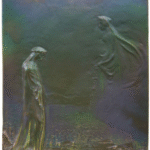Clément Massier
Biography
Clément Massier (1844–1917) belonged to a dynasty of ceramists active in Vallauris well before the French Revolution. His father, Jacques Massier (1806–1871), along with Jacques’s brother Jérôme Massier (1820–1909), represented the family’s central lineage, and Jacques was himself the father of both Delphin Massier (1836–1907) and Clément.
By the mid-nineteenth century, ceramic workshops in Vallauris focused primarily on culinary wares, and the Massier atelier followed this demand, though Jacques also began to explore more artistic directions. A decisive turning point came in 1859 with the arrival of the Italian ceramist Gaetano Gandolfi, who had a formative influence on the young Clément, then twelve years old. Fascinated by Gandolfi, he became his pupil, learning the techniques of enamelled faience, the preparation of glazes, and a more artistic production inspired by Neoclassicism.
Thus, Clément’s training took place in his father’s atelier, enriched by skilled artisans such as Gandolfi, who oriented production toward the artistic rather than the purely utilitarian. Clément later opened his own workshop in Vallauris, while his brother Delphin and cousin Jérôme fils each managed their own manufactories. Confronted with strong family competition, he chose in 1883 to establish a new manufactory at Golfe-Juan, a strategic location benefiting from the flow of tourists and the convenience of railway transport for rapid and secure shipping. His Scottish-born wife, Marie Dewick (1852–1900), assisted him in this venture.
The factory soon employed more than 120 workers, and Massier promoted his production through photographic catalogues and illustrated postcards. His ceramics achieved notable commercial success, prompting him to open several branches in Paris—first at 36 rue de l’Opéra, then at 206 rue de Rivoli, later at 17 rue du Paradis, and finally at 119 rue du Chemin Vert. This Parisian expansion was followed by the dissemination of his ceramics across Europe.
The central pursuit of Clément Massier’s career was the refinement of the technique of lustre métallique, which endowed his works with a distinctive iridescent, metallic glaze. Throughout his career, he also collaborated with prominent artists, including the Scottish sculptor Alexander Munro (1825–1871) and the French Symbolist painter Lucien Lévy-Dhürmer (1865–1953).
As a leading figure in artistic ceramics, he participated in the great international exhibitions, receiving, among other distinctions, a gold medal at the Exposition Universelle of 1889. Clément Massier died in 1917, leaving behind a legacy as one of the foremost innovators in modern French ceramics.

